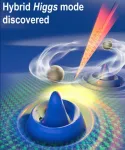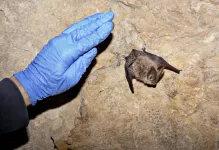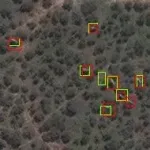(Press-News.org) AMES, Iowa - Even if you weren't a physics major, you've probably heard something about the Higgs boson.
There was the title of a 1993 book by Nobel laureate Leon Lederman that dubbed the Higgs "The God Particle." There was the search for the Higgs particle that launched after 2009's first collisions inside the Large Hadron Collider in Europe. There was the 2013 announcement that Peter Higgs and Francois Englert won the Nobel Prize in Physics for independently theorizing in 1964 that a fundamental particle - the Higgs - is the source of mass in subatomic particles, making the universe as we know it possible.
(Plus, there are the Iowa State University physicists on the author list of a 2012 research paper describing how the ATLAS Experiment at the collider observed a new particle later confirmed to be the Higgs.)
And now Jigang Wang, a professor of physics and astronomy at Iowa State and a senior scientist at the U.S. Department of Energy's Ames Laboratory, and a team of researchers have discovered a form of the famous particle within a superconductor, a material capable of conducting electricity without resistance, generally at very cold temperatures.
Wang and his collaborators - including Chang-Beom Eom, the Raymond R. Holton Chair for Engineering and Theodore H. Geballe Professor at the University of Wisconsin-Madison; Ilias Perakis, professor and chair of physics at the University of Alabama at Birmingham; and Eric Hellstrom, professor and interim chair of mechanical engineering at Florida State University - report the details in a paper recently published online by the journal Nature Communications.
They write that in lab experiments they've found a short-lived "Higgs mode" within iron-based, high-temperature (but still very cold), multi-energy band, unconventional superconductors.
A quantum discovery
This Higgs mode is a state of matter found at the quantum scale of atoms, their electronic states and energetic excitations. The mode can be accessed and controlled by laser light flashing on the superconductor at terahertz frequencies of trillions of pulses per second. The Higgs modes can be created within different energy bands and still interact with each other.
Wang said this Higgs mode within a superconductor could potentially be used to develop new quantum sensors.
"It's just like the Large Hadron Collider can use the Higgs particle to detect dark energy or antimatter to help us understand the origin of the universe," Wang said. "And our Higgs mode sensors on the table-top have the potential help us discover the hidden secrets of quantum states of matter."
That understanding, Wang said, could advance a new "quantum revolution" for high-speed computing and information technologies.
"It's one way this exotic, strange, quantum world can be applied to real life," Wang said.
Light control of superconductors
The project takes a three-pronged approach to accessing and understanding the special properties, such as this Higgs mode, hidden within superconductors:
Wang's research group uses a tool called quantum terahertz spectroscopy to visualize and steer pairs of electrons moving through a superconductor. The tool uses laser flashes as a control knob to accelerate supercurrents and access new and potentially useful quantum states of matter.
Eom's group developed the synthesis technique that produces crystalline thin films of the iron-based superconductor with high enough quality to reveal the Higgs mode. Hellstrom's group developed deposition sources for the iron-based superconducting thin film development.
Perakis' group led the development of quantum models and theories to explain the results of the experiments and to simulate the salient features that come from the Higgs mode.
The work has been supported by a grant to Wang from the National Science Foundation and grants to Eom and Perakis from the U.S. Department of Energy.
"Interdisciplinary science is the key here," Perakis said. "We have quantum physics, materials science and engineering, condensed matter physics, lasers and photonics with inspirations from fundamental, high-energy and particle physics."
There are good, practical reasons for researchers in all those fields to work together on the project. In this case, students from the four research groups worked together with their advisors to accomplish this discovery.
"Scientists and engineers," Wang wrote in a research summary, "have recently come to realize that certain materials, such as superconductors, have properties that can be exploited for applications in quantum information and energy science, e.g., processing, recording, storage and communication."
INFORMATION:
Read the paper
"Light quantum control of persisting Higgs modes in iron-based superconductors, Nature Communications, Jan. 11, 2021.
The Research Team
In addition to Wang, Eom, Perakis and Hellstrom, the research team includes:
From Iowa State University, Chirag Vaswani, Liang Luo, Xu Yang, Di Cheng, Chuankun Huang, Richard H. Kim, Zhaoyu Liu; from the University of Wisconsin-Madison, Jong-Hoon Kang, Christopher Sundahl; from the University of Alabama at Birmingham, Martin Mootz; from Florida State University, Yesusa Collantes.
BROOKLYN, New York, Tuesday, January 19, 2021 - The World Health Organization END ...
WASHINGTON, January 19, 2021 -- A Velcro-like fastener with a microscopic design that looks like tiny mushrooms could mean advances for everyday consumers and scientific fields like robotics.
In Biointerphases, published by AIP Publishing, researchers from Wageningen University in the Netherlands show how the design can use softer materials and still be strong enough to work.
Probabilistic fasteners work, because they are designed with a tiny pattern on one surface that interlocks with features on the other surface. Currently available fasteners, like Velcro and 3M, are called hook and loop fasteners. That design requires harder, stiff material, which ...
Even prior to the pandemic, burnout among health care professionals was a pervasive public health concern, with END ...
Large-scale land acquisitions by foreign investors, intended to improve global food security, had little to no benefit, increasing crop production in some areas while simultaneously threatening local food security in others, according to researchers who studied their effects.
The END ...
CORVALLIS, Ore. - Tiny amounts of gender bias in employee hiring decisions contribute to concerning rates of discrimination and productivity losses that together represent significant costs, financial and otherwise, for employers, a new study from Oregon State University has found.
Gender bias is a subtle, unintentional preference for one gender over the other. Despite significant efforts to reduce bias in hiring over the last several decades, it continues to persist and pose potential problems for companies, said Jay Hardy, an assistant professor of management in OSU's College ...
BOZEMAN, Montana (January 19, 2021) - A four-year study recently published in Ecology and Evolution concludes that the fungal disease, white-nose syndrome, poses a severe threat to many western North American bats.
Since it was first detected in 2006, white-nose syndrome has killed millions of bats in eastern and central North America. The spread of the fungal pathogen that causes white-nose syndrome in hibernating bats has reached several western U.S. states, mostly likely through bat-to-bat spread, and is presently threatening western species.
Bats with white-nose syndrome have fungus growing on their nose and wings, as the name implies, but the fungal infection also triggers a higher frequency of arousals from hibernation. ...
Anyone who has tried and failed to meditate knows that our minds are rarely still. But where do they roam? New research led by UC Berkeley has come up with a way to track the flow of our internal thought processes and signal whether our minds are focused, fixated or wandering.
Using an electroencephalogram (EEG) to measure brain activity while people performed mundane attention tasks, researchers identified brain signals that reveal when the mind is not focused on the task at hand or aimlessly wandering, especially after concentrating on an assignment.
Specifically, increased alpha brain waves were detected in the prefrontal cortex of ...
For the first time, scientists have successfully used satellite cameras coupled with deep learning to count animals in complex geographical landscapes, taking conservationists an important step forward in monitoring populations of endangered species.
For this research, the satellite Worldview 3 used high-resolution imagery to capture African elephants moving through forests and grasslands. The automated system detected animals with the same accuracy as humans are able to achieve.
The algorithm that enabled the detection process was created by Dr Olga Isupova, a computer scientist at the University of Bath in the UK. The project was a collaboration with the UK's University of Oxford and the University of Twente in the Netherlands.
Dr ...
People's fear of 5G technology is rational. Such technology does emit radiation, even if it's at low levels. But 5G isn't all that different from 4G, and it certainly doesn't cause COVID-19 despite such rumors having spread rapidly across the globe.
Researchers need to better understand how misinformation like this spreads in order to hone their intervention efforts and prevent misinformed perspectives from taking root. In society's virtual world, preventing technological misinformation, in particular, is important now more than ever.
A research team led by Elaine Nsoesie, a Hariri Institute Faculty Fellow, investigated how COVID-19 misinformation proliferated using ...
A new study out of the University of Chicago and Stanford University on pairs of twins with and without food allergies has identified potential microbial players in this condition. The results were published on Jan. 19 in the Journal of Clinical Investigation.
The study grew out of prior research in the Nagler laboratory at UChicago on the fecal microbiota in infants. By transplanting fecal microbes from healthy and food-allergic infants to germ-free mice (who do not possess a microbiome), investigators found that the healthy infant microbiota was protective against the development ...





